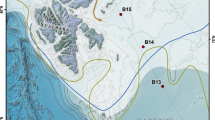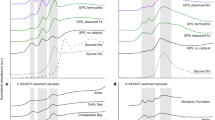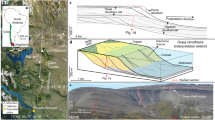Abstract
The sources and burial processes of organic matter in marine sediments are not well understood, yet they are important if we are to have a better understanding of the global carbon cycle1. In particular, the nature and fraction of the terrestrial organic carbon preserved in marine sediments is poorly constrained. Here we use the chemical and stable carbon isotope signatures of oxidation products from a macromolecular component (lignin)2 of the terrigenous organic matter preserved in offshore surface sediments in the Gulf of Mexico to complement similar data from an existing onshore transect3 in this region. The complete onshore–offshore data set, along with radiocarbon dates of the bulk organic material at the same sites, allows the differentiation of material originating from plants that photosynthesize using the C4 mechanism from those that undergo C3 photosynthesis. We conclude that the offshore lignins derive from erosion of the extensive grassland (C4) soils of the Mississippi River drainage basin, and that the nearshore lignins originate largely from C3 plant detritus from coastal forests and swamps. This distribution is probably due to the hydrodynamic sorting of the different source materials4 during their seaward transport. These results suggest that previous studies3,5 have significantly underestimated the terrigenous fraction of organic matter in offshore sediments by not recognizing the contribution of C4 vegetation to the carbon-isotope composition. Such an underestimate may force revisions in the assessment of past marine primary productivity and associated organic carbon fluxes6, and of organic matter preservation/remineralization7 and nutrient cycling8 in marine sediments.
This is a preview of subscription content, access via your institution
Access options
Subscribe to this journal
Receive 51 print issues and online access
$199.00 per year
only $3.90 per issue
Buy this article
- Purchase on Springer Link
- Instant access to full article PDF
Prices may be subject to local taxes which are calculated during checkout



Similar content being viewed by others
References
Hedges, J. I. Global biogeochemical cycles: Progress and problems. Mar. Chem. 39, 67–93 (1992).
Goñi, M. A. & Eglinton, T. I. Stable carbon isotopic analyses of lignin-derived CuO oxidation products by isotope ratio monitoring–Gas Chromatography–Mass spectrometry (irm–GC–MS). Org. Geochem. 24, 601–615 (1966).
Hedges, J. I. & Parker, P. L. Land-derived organic matter in surface sediments from the Gulf of Mexico. Geochim. Cosmochim. Acta 40, 1019–1029 (1976).
Keil, R. G., Tsamakis, E., Bor Fuh, C., Giddings, J. C. & Hedges, J. I. Mineralogical and textural controls on the organic composition of coastal marine sediments: hydrodynamic separation using SPLITT-fractionation. Geochim. Cosmochim. Acta 58, 879–893 (1994).
Jasper, J. P. & Gagosian, R. B. Glacial-interglacial climatically forced δ13C variations in sedimentary organic matter. Nature 342, 60–62 (1989).
Müller, P. J. & Suess, E. Productivity, sedimentation rate, and sedimentary organic matter in the ocean. I. Organic carbon preservation. Deep Sea Res. 26, 1347–1367 (1979).
Hedges, J. I. & Keil, R. G. Sedimentary organic matter preservation: an assessment and speculative synthesis. Mar. Chem. 49, 81–115 (1995).
Martin, J. H., Knauer, G. A., Karl, D. M. & Broenkow, W. W. VERTEX: Carbon cycling in the northeast Pacific. Deep Sea Res. 34, 267–285 (1987).
Van Andel, T. H. in Recent Sediments, Northwestern Gulf of Mexico(eds Shepard, F. P., Phleger, F. B. & Van Andel, T. H.) 34–55 (American Assoc. of Petrology and Geology, Tulsa, (1960).
Sims, P. L. & Coupland, R. T. Producers. in Grassland Ecosystems of the World: Analyses of Grasslands and their Uses(ed. Coupland, R. T.) 49–72 (Cambridge Univ. Press, (1979).
Deegan, L. A.et al.in Estuary Variability(ed. Wolfe, D. A.) 83–100 (Academic, New York, (1986).
Ruttenberg, K. C. & Goñi, M. A. Phosphorous distribution, C : N : P ratios, and δ13COC in arctic, temperate, and tropical coastal sediments: tools for characterizing bulk sedimentary organic matter. Mar. Geol. 139, 123–145 (1997).
Stuiver, M., Peason, G. W. & Braziunas, T. Radiocarbon age calibration of marine samples back to 9,00 cal yr. bp. Radiocarbon 28, 980–1021 (1986).
Eglinton, T. I. et al. Variability in radiocarbon ages of individual organic compounds from marine sediments. Science 277, 796–799 (1997).
Emerson, S. C. et al. Organic carbon in surface deep-sea sediments: C-14 concentration. Nature 329, 51–54 (1987).
Hedges, J. I. & Mann, D. C. The characterization of plant tissues by their cupric oxide oxication products. Geochim. Cosmochim. Acta 43, 1803–1807 (1979).
Opsahl, S. & Benner, R. Early diagenesis of vascular plant tissues: lignin and cutin decomposition and biogeochemical implications. Geochim. Cosmochim. Acta 59, 4889–4904 (1995).
Goñi, M. A., Nelson, B., Blanchette, R. A. & Hedges, J. H. Fungal degradation of wood lignins: geochemical perspectives from CuO-derived phenolic dimers and monomers. Geochim. Cosmochim. Acta 57, 3985–4002 (1993).
Hedges, J. I. et al. Compositions and fluxes of particulate organic material in the Amazon river. Limnol. Oceanogr. 31, 717–738 (1986).
Ziegler, F., Kögel, I. & Zech, W. Z. Alteration of gymnosperm and angiosperm lignin during decomposition in forest humus layers. Z. Pflanzenernaehr. Bodenk. 149, 323–331 (1986).
Teeri, J. A. & Stowe, L. G. Climatic patterns and the distribution of C4 grasses in North America. Oecologia 23, 1–12 (1976).
Tieszen, L. L. & Archer, S. in Plant Biology of the Basin and Range(eds Osmond, C. S., Pitelka, L. F. & Hidy, G. M.) 293–321 (Ecological Studies Ser. Vol. 80, Springer, Heidelberg, (1990).
Parton, W. J., Schimel, D. S., Cole, C. V. & Ojima, D. S. Analysis of factors controlling soil organic matter levels in Great Plains grasslands. Soil Sci. Soc. Am. J. 51, 1173–1179 (1987).
Chmura, G. L. Palynomorph distribution in marsh environments in the modern Mississippi Delta Plain. Geol. Soc. Am. Bull. 106, 705–714 (1994).
Prahl, F. G., Ertel, J. R., Goñi, M. A., Sparrow, M. A. & Eversmeyer, B. Terrestrial organic carbon contributions to sediments on the Washington margin. Geochim. Cosmochim. Acta 58, 3035–3048 (1994).
Goñi, M. A. in Proceedings of the Ocean Drilling Program, Sci. Rep. 155(eds Flood, R. D., Piper, D. J. W. & Klaus, A.) 519–530 (College Station, TX, (1997).
France-Lanord, C. & Derry, L. A. δ13C of organic carbon in the Bengal Fan: source evolution and transport of C3 and C4 plant carbon to marine sediments. Geochim. Cosmochim. Acta 58, 4809–4814 (1994).
Parton, W. J. et al. Observations and modeling of biomass and soil organic matter dynamics for the grassland biome worldwide. Global Biochem. Cycles 7, 785–809 (1993).
Bird, M. I. et al. Terrestrial vegetation change inferred from n-alkane δ13C analysis in the marine environment. Geochim. Cosmochim. Acta 59, 2853–2857 (1995).
Cerling, T. E., Wang, Y. & Quade, J. Expansion of C4 ecosystems as an indicator of global ecological change in the late Miocene. Nature 361, 344–345 (1993).
Acknowledgements
We thank J. W. Morse for the opportunity to participate on the cruise in Gulf of Mexico; E. Tsamakis, K. Tholke, R. Ostermann, J. Irvine, N. Parmentier, L. Christman, J. Donahue and E.Tappa for help with sample preparation and analyses; and G. Eglinton, B. Fry, J. Jasper, J. Hedges, R.Benner, S. Smith and S.Montgomery for comments and discussions. This work was supported by the US NSF.
Author information
Authors and Affiliations
Corresponding author
Rights and permissions
About this article
Cite this article
Goñi, M., Ruttenberg, K. & Eglinton, T. Sources and contribution of terrigenous organic carbon to surface sediments in the Gulf of Mexico. Nature 389, 275–278 (1997). https://doi.org/10.1038/38477
Received:
Accepted:
Issue Date:
DOI: https://doi.org/10.1038/38477
This article is cited by
-
Phosphorus speciation, transformation and benthic processes with implications for environmental impacts in the aquaculture area of Rushan Bay
Acta Oceanologica Sinica (2023)
-
Biomarkers reveal the terrigenous organic matter enrichment in the late Oligocene—early Miocene marine shales in the Ying-Qiong Basin, South China Sea
Acta Oceanologica Sinica (2023)
-
Analysis and Model Comparison of Carbon and Nitrogen Concentrations in Sediments of the Yellow Sea and Bohai Sea by Visible-Near Infrared Spectroscopy
Bulletin of Environmental Contamination and Toxicology (2022)
-
The Potential of Mangrove-Derived Organic Matter in Sediments for Tracing Mangrove Development During the Holocene
Estuaries and Coasts (2021)
-
Terrestrial Organic Matter Inputs to Nearshore Marine Sediment Under Prolonged Drought Followed by Significant Rainfall as Indicated by Lignin
Estuaries and Coasts (2021)
Comments
By submitting a comment you agree to abide by our Terms and Community Guidelines. If you find something abusive or that does not comply with our terms or guidelines please flag it as inappropriate.



